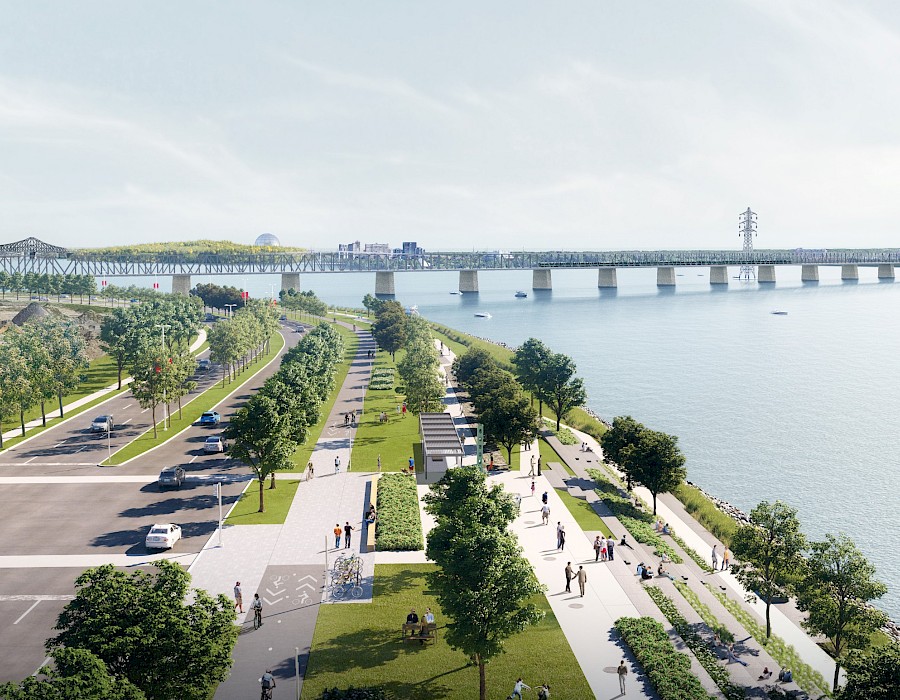Column
Greening the Bonaventure Sector

Jean Giguère
Author :
WikiResidence
Source :
17/08/25
The transformation of the former Bonaventure expressway into an urban boulevard is a major
project that goes far beyond simple road repair.
By creating an 80,000 m² green corridor, the City of Montreal is not only tackling heat islands
but also strengthening connectivity between neighborhoods undergoing a major transformation,
from Downtown Montreal, Griffintown to Nuns' Island.
This article explores how this project fits into a global vision of urban development, by linking to
major projects in the sector, notably the new Griffintown market, the Bridge-Bonaventure
mega-district, and developments around the REM.
The Bonaventure sector, once synonymous with a highway leading to downtown, is in the process of transforming into a true axis of life. The shift from a purely road-centric approach to a human-centric one marks a turning point for Montreal urban planning.
The planned transformation, which includes greening, bike paths, and a pedestrian promenade, is a central element of a broader development strategy that affects several surrounding neighborhoods.
A Greening Project at the Heart of a Global Vision
The Bonaventure greening project is part of a municipal desire to increase the presence of nature in the city to combat the effects of climate change.
With the planting of thousands of trees, shrubs, and perennials, the new boulevard will not only be aesthetic: it will help reduce heat islands, promote biodiversity, and offer outdoor relaxation spaces.
Although the construction may cause minor disruptions, these inconveniences are temporary and are a prelude to lasting benefits for the community.
Vital Connections with Major Projects
This new green axis does not exist in a vacuum. It serves as a connecting thread between several major development projects that are redefining the face of Montreal's Southwest.
Griffintown in full effervescence: The greening of Bonaventure strengthens the link with Griffintown, a historic neighborhood in full revitalization.
The new public spaces and active mobility lanes facilitate access to the heart of the neighborhood, where new real estate projects and a market project aim to create a more complete and lively living environment, while preserving the sector's industrial character.
The Bridge-Bonaventure mega-district:
The redevelopment of Bonaventure is an important step towards the creation of the Bridge-Bonaventure mega-district.
This ambitious project, which plans for thousands of housing units and significant green spaces, aims to transform a brownfield into an eco-district.
The new Bonaventure boulevard becomes a green gateway between this future innovation hub and downtown, facilitating walking and cycling and promoting a development approach focused on clean technologies.
Nuns' Island and its PPU: The Bonaventure developments also improve the connection with Nuns' Island, particularly the northern part of the neighborhood.
The Particular Urban Planning Program (PPU) for this sector, which aims to create a living environment structured around the future REM station, is based on these same principles of sustainable mobility and access to green spaces.
Island residents, already accustomed to projects near the REM and their own parks, will benefit from easy and safe access to neighboring neighborhoods, which strengthens the sense of community and the coherence of the entire territory.
Impacts and Benefits for the Community
The development of these green spaces is measured not only in square meters but also in terms of social and economic impact.
As some studies point out, the creation of urban parks can increase the property value of neighboring properties.
More importantly, these projects are true levers for community development, by offering spaces that encourage physical activity, relaxation, and social interactions, which are fundamental aspects of the quality of life for Montrealers.
These new developments are integrated into the urban ecosystem to create a synergy between neighborhoods, while highlighting the strengths of each.
